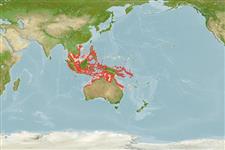Common names from other countries
Environment: milieu / climate zone / depth range / distribution range
Ecologia
marino associati a barriera corallina; non migratori; distribuzione batimetrica 1 - 50 m (Ref. 9710). Tropical; 20°N - 24°S, 97°E - 163°E (Ref. 5222)
Western Pacific: Philippines to Australia (Dampier Islands, off Western Australia to the Capricorn Islands, of the southern Great Barrier Reef); including Palau, New Britain, and the Solomon Islands.
Size / Peso / Age
Maturity: Lm ? range ? - ? cm
Max length : 55.0 cm TL maschio/sesso non determinato; (Ref. 118794)
Spine dorsali (totale): 9; Raggi dorsali molli (totale): 15-17; Spine anali 3; Raggi anali molli: 7 - 8. Juveniles dark brown with bright yellow dorsal, anal, pelvic and tail fins. At size about 9 cm, small scattered blue dots appear and yellow on fins begins to recede (Ref. 37816); characterized further by brown to reddish brown color, usually mottled; head, body and fins covered with numerous white to bluish spots; several pale bars evident on side; scales ctenoid scales on body including abdomen; greatest body depth 2.6-3.0 in SL; rounded caudal fin; pelvic fins 1.8-2.1 in head length (Ref. 90102).
Inhabits shallow protected coastal reefs, in seagrass beds, and in coral-rich areas (Ref. 9710, 48635). Feeds on crustaceans and fishes (Ref. 37816). Solitary (Ref 90102). Protogynous hermaphrodite (Ref. 089707).
Life cycle and mating behavior
Maturità | Riproduzione | Deposizione | Uova | Fecundity | Larve
Heemstra, P.C. and J.E. Randall, 1993. FAO Species Catalogue. Vol. 16. Groupers of the world (family Serranidae, subfamily Epinephelinae). An annotated and illustrated catalogue of the grouper, rockcod, hind, coral grouper and lyretail species known to date. Rome: FAO. FAO Fish. Synop. 125(16):382 p. (Ref. 5222)
IUCN Red List Status (Ref. 130435)
CITES (Ref. 128078)
Not Evaluated
Threat to humans
Harmless
Human uses
Pesca: scarso interesse commerciale
Informazioni ulteriori
BibliografiaAcquacolturaProfilo di acquacolturaVarietàGeneticaElectrophoresesEreditarietàMalattieElaborazioneMass conversion
CollaboratoriImmaginiStamps, Coins Misc.SuoniCiguateraVelocitàModalità di nuotoArea branchialeOtolithsCervelliVista
Strumenti
Special reports
Download XML
Fonti Internet
Estimates based on models
Preferred temperature (Ref.
115969): 25.6 - 29, mean 28.3 (based on 758 cells).
Phylogenetic diversity index (Ref.
82804): PD
50 = 0.5000 [Uniqueness, from 0.5 = low to 2.0 = high].
Bayesian length-weight: a=0.01349 (0.00847 - 0.02147), b=3.02 (2.89 - 3.15), in cm Total Length, based on LWR estimates for this species & Genus-body shape (Ref.
93245).
Trophic level (Ref.
69278): 4.2 ±0.74 se; based on food items.
Resilienza (Ref.
120179): Basso, tempo minimo di raddoppiamento della popolazione 4.5 - 14 anni (Preliminary K or Fecundity.).
Fishing Vulnerability (Ref.
59153): High vulnerability (58 of 100).
